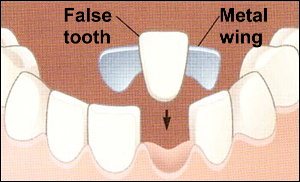|
.
Dr. Hall, Ed G Ed,  Diagram of a Maryland bridge Many dentists have problems with Maryland bridges, resulting in a short lifespan for the bridge. They seem really simple to place—grind the adjacent teeth a little to make space for the metal framework, and then just bond it on. But it’s not quite that simple. There should be certain grooves placed in the preparation to resist the forces that will occur. Otherwise it is very easy to dislodge a Maryland bridge. And you have the added complication of having porcelain crowns on the adjacent teeth. The ideal is to bond the metal wings of the Maryland bridge to enamel. That gives the strongest bond. Bonding the bridge to porcelain is inherently weaker, even if it’s done right. And very few dentists know how to bond to porcelain. Then there is the additional complication of having to prepare the teeth with the porcelain crowns so that they have the proper grooves, with retention and resistance form that will help keep the bridge from coming loose. Placing proper grooves could cause the groove preparations to go through the porcelain entirely and reach the underlying metal. Now, instead of bonding to porcelain, the dentist needs to bond to metal, which is more difficult still. So yes, it can be done. But it’s a high-risk, difficult procedure. The ideal would be if the dentist would anticipate this possibility back when the original implants were placed. Knowing there is one natural tooth left between the implants, the dentist should be anticipating that at some point in the future the patient could lose that tooth. Then the implants for the missing teeth should be placed so that the abutments end up parallel and then use a screw-retained crown. When the tooth in between is lost, the dentist would simply unscrew the adjacent crowns and replace them with a bridge. Another solution would be to place a third implant in the missing space, assuming there is enough space in the bone to accommodate a third implant. Do you have a comment? We’d love to hear from you. Enter your comment below. Click here to ask Dr. Hall a question of your own. |
About David A. Hall
Dr. David A. Hall was one of the first 40 accredited cosmetic dentists in the world. He practiced cosmetic dentistry in Iowa, and in 1990 earned his accreditation with the American Academy of Cosmetic Dentistry. He is now president of Infinity Dental Web, a company in Mesa, Arizona that does advanced internet marketing for dentists.

Leave a Reply